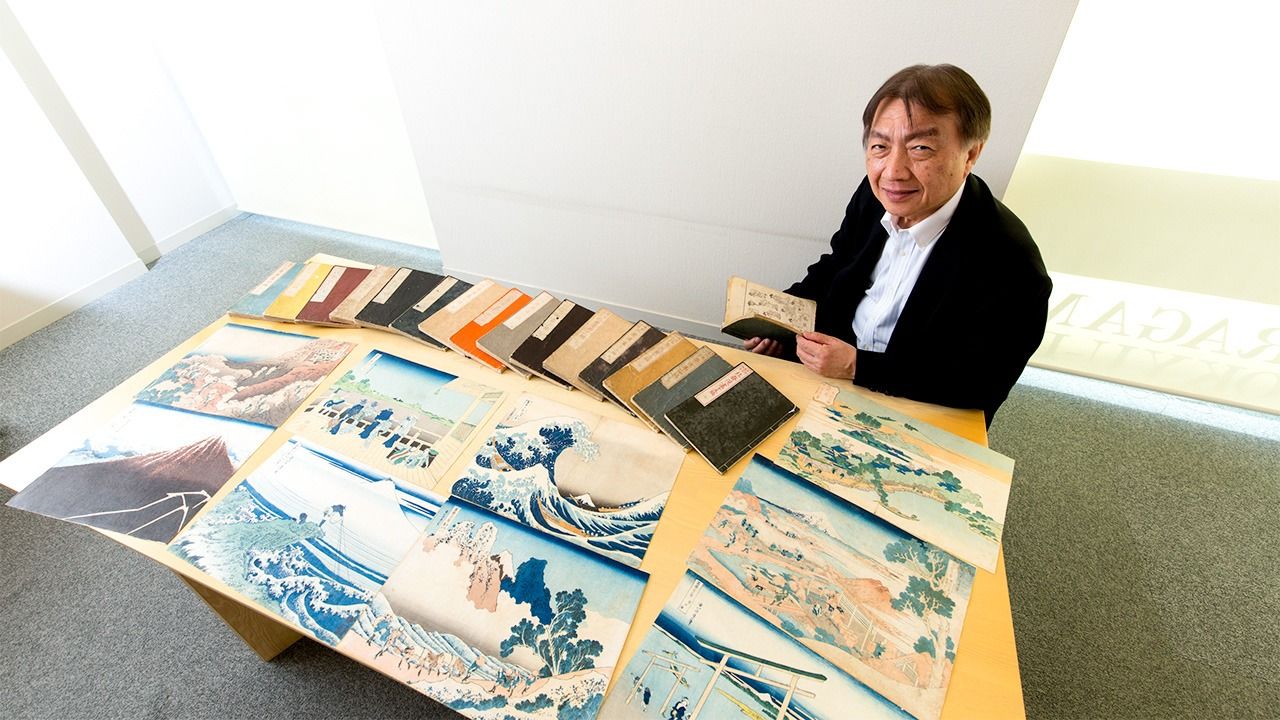
Hidden Treasures: Japan Should Show Off its “Ukiyo-e” Classics
Culture Travel Global Exchange Arts- English
- 日本語
- 简体字
- 繁體字
- Français
- Español
- العربية
- Русский
INTERVIEWER Ukiyo-e is a enjoying something of a resurgence in Japan and around the world. The new Japanese passports incorporate designs from the series Thirty-Six Views of Mount Fuji by Katsushika Hokusai. At a US auction in March this year, two prints from that series—Fine Wind, Clear Morning [commonly known as Red Fuji] and The Great Wave off Kanagawa—each sold for more than 500,000 dollars. What’s your take on this phenomenon?
URAGAMI MITSURU The real eye-opener for me came in 2017, when Christie’s auctioned off a print of Hokusai’s Great Wave for almost 1 million dollars. The prints that were sold last March weren’t nearly as good as that one in terms of quality or condition. But even so, they went for more than a half a million each.
Generally speaking, the art market in Japan has been rather depressed over the past decade. Much of the top-quality art formerly held in private Japanese collections, including Chinese ceramics and French Impressionist paintings, has flowed out of the country. In terms of Japanese art, the only two genres that have held their own in recent years are Meiji-era crafts and ukiyo-e. And those are sought after worldwide. So, I’d say the biggest factor is a renewed appreciation of ukiyo-e on the international art market.
In the Edo period [1603–1868], designs by ukiyo-e artists were carved into woodblocks and printed off in the thousands. There were probably about 5,000 original impressions of the Great Wave, but the vast majority have been lost. Today, there are only about 150 or 200 copies left in the world, and most of those are in museum collections. So when a decent print comes on the market, it’s going to fetch a high price.
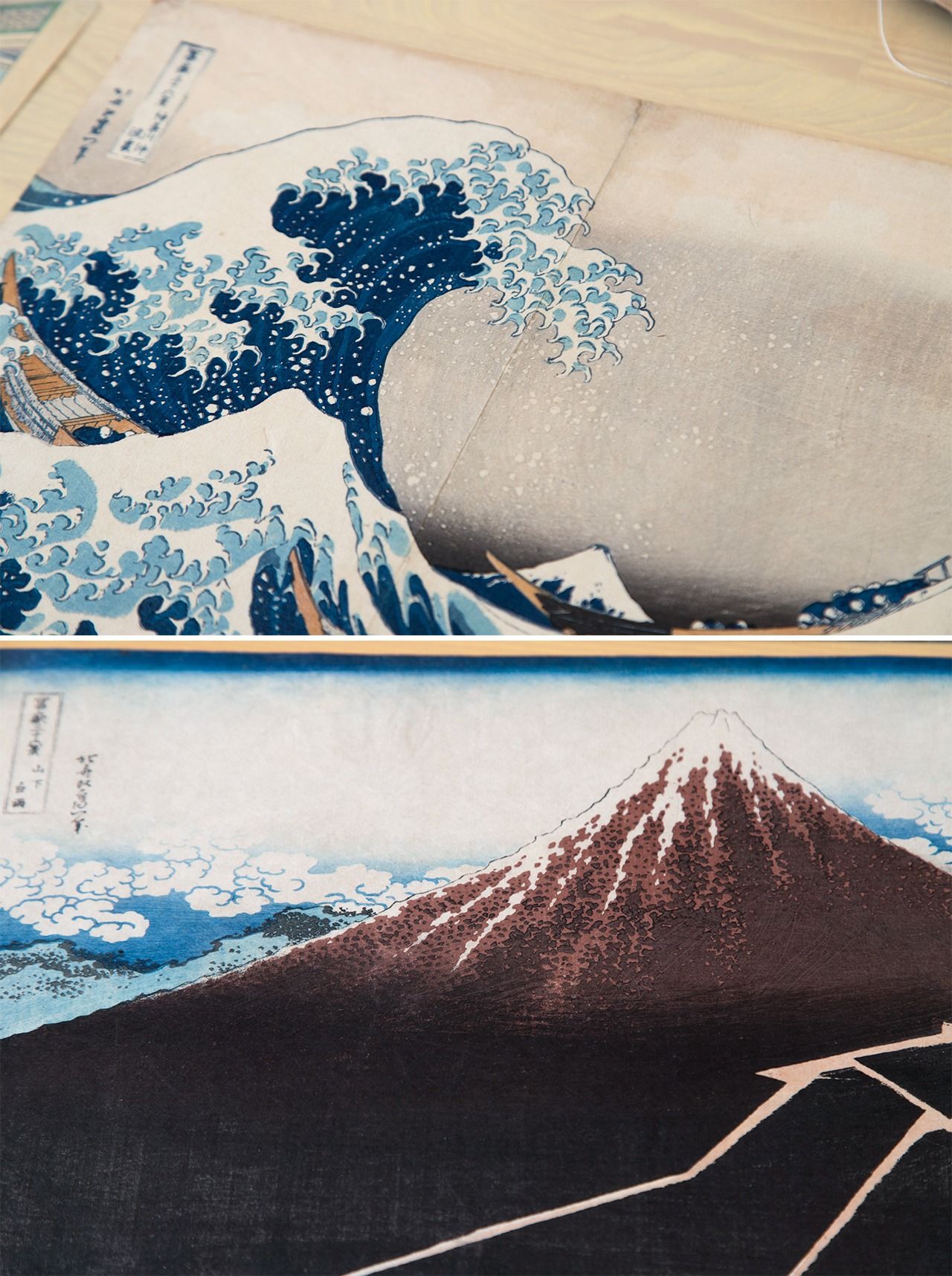
The Great Wave off Kanagawa (above) and Shower Below the Summit from Katsushika Hokusai’s Thirty-Six Views of Mount Fuji, both in the private collection of Uragami Mitsuru.
Exposing Ukiyo-e to the Light of Day
INTERVIEWER International tourism in Japan is on the rise, and what with this year’s Rugby World Cup and the 2020 Summer Olympic Games, I’m sure we can expect an even bigger influx over the next couple of years. Where should we tell foreign visitors to go if they come here in hopes of seeing great ukiyo-e?
URAGAMI It’s natural to assume that Japan is the best place to view the finest ukiyo-e prints. Unfortunately, that’s not really the case. I’m afraid that travelers who come here with such high expectations are going to be disappointed.
In terms of collections, the Tokyo National Museum in Ueno has a large number of ukiyo-e prints from the former Matsukata collection. There’s also the Ōta Memorial Museum of Art in Harajuku, which specializes in ukiyo-e, and the Sumida Hokusai Museum, which opened in Tokyo in 2016. But the permanent exhibits of ukiyo-e at those museums are really not very impressive. The works most people want to see just don’t come out of storage that often.
INTERVIEWER Visitors to Paris can see the Mona Lisa any time they visit the Louvre. Why is it different for ukiyo-e masterpieces?
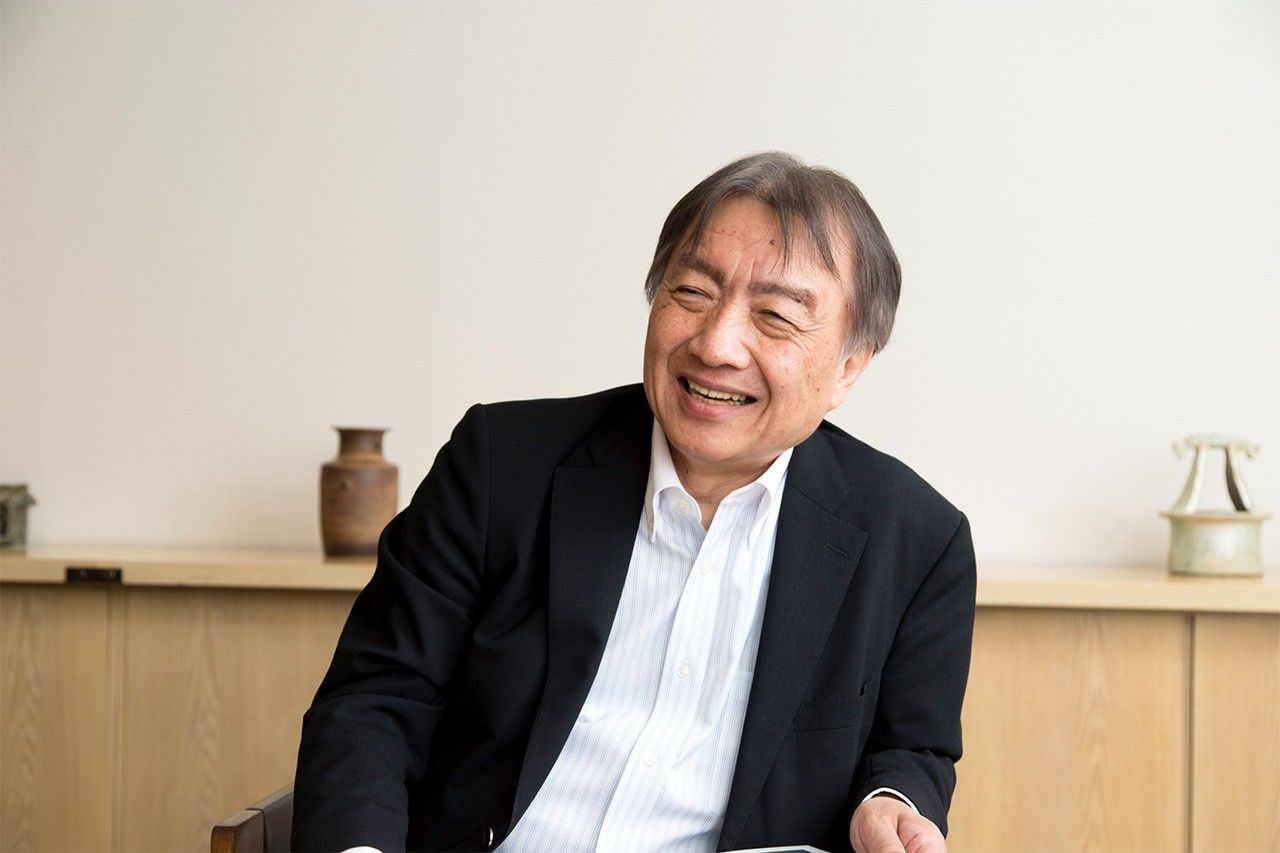
Ukiyo-e collector and expert Uragami Mitsuru.
URAGAMI It’s difficult to exhibit ukiyo-e prints continuously because the pigments fade easily when exposed to light. At the Sumida Hokusai Museum, the rule is that no single print can be on display for more than one month out of the year. So, if a work has been shown once, it won’t come out again that year—not even for a special exhibition.
Museums have a responsibility to preserve their art, as well as to display it to the public, and it can be very difficult to strike the right balance. That said, if museum-goers aren’t impressed by the exhibits and the artwork they see, the museum isn’t going to attract publicity or draw visitors. With the development of LED lighting in recent years, it’s possible to reduce ultraviolet radiation substantially. I think it may be time to consider increasing the maximum display time to two or three months out of the year.
But it would also be great if we had some special facilities that would allow for continuous display of the most iconic ukiyo-e masterpieces—works like the Hokusai manga and Thirty-Six Views of Mount Fuji, along with Utagawa Hiroshige’s Fifty-Three Stations of the Tōkaidō and One Hundred Famous Views of Edo. Those exhibits would be a magnet for art lovers from all over the world. Visitors would come away with a new appreciation for Japanese art and culture, and our international image would benefit.
Museums are a major element of tourist infrastructure. The British Museum in London, the Louvre in Paris, the Prado in Madrid . . . these are must-see attractions for tourists from around the world, Japan included. Why does everyone want to visit museums? To view cultural artifacts that embody a nation’s identity. Unfortunately, the Tokyo National Museum doesn’t quite measure up.
The Japanese government talks about building tourism into a major industry, but I’m afraid Japan’s cultural infrastructure is a little underdeveloped for that.
Reaffirming the Role of Art in Society
INTERVIEWER It does look as if the government is moving in that direction—opening the Kyoto State Guest House to the public year-round, expanding evening hours for the national museums, and so forth.
URAGAMI So, the museums’ hours are a bit longer, but their budgets are being cut year by year. The Japanese government allocates an embarrassingly small amount for cultural affairs. And most of that goes to the repair and upkeep of old temples and shrines, so there’s scarcely anything left over for new projects.
As an executive officer of the Tokyo Art Club, I’ve been lobbying for almost twenty years to turn the Cultural Affairs Agency into a full-fledged ministry, but the campaign has gone nowhere. Why? Because Japanese politicians and bureaucrats—for all their talk about the need to project our culture abroad—don’t truly appreciate the power of culture and the arts.
Many in the West feel more respect for someone who can speak knowledgeably about culture. A number of world leaders are art lovers. When you bring up the arts, they come alive. Prime Minister Abe Shinzō’s international cachet would rise significantly if he could speak intelligently about the arts in Japan—as opposed to just Japanese food and sake. As our nation’s top leader, he should bring a little something extra to the table.
Before the 2016 G7 Ise-Shima Summit, there was talk of using Hokusai images to decorate the conference room. I wish they had followed through on that.
There’s a story that not long after Japan’s defeat in World War II, Yoshida Shigeru hosted an important meeting with US Occupation authorities at the former palace of Prince Asaka [now the Tokyo Metropolitan Teien Art Museum]. For the occasion, he had various masterworks of Japanese art put on display. At that time, the young American officials serving under the Supreme Commander for the Allied Powers tended to look on Japan as an uncivilized country, but apparently their attitude changed when they saw these works of art. These officials were products of an elite education, and they had genuine respect for great art. As a result, Yoshida was able to steer the meeting in a positive direction.
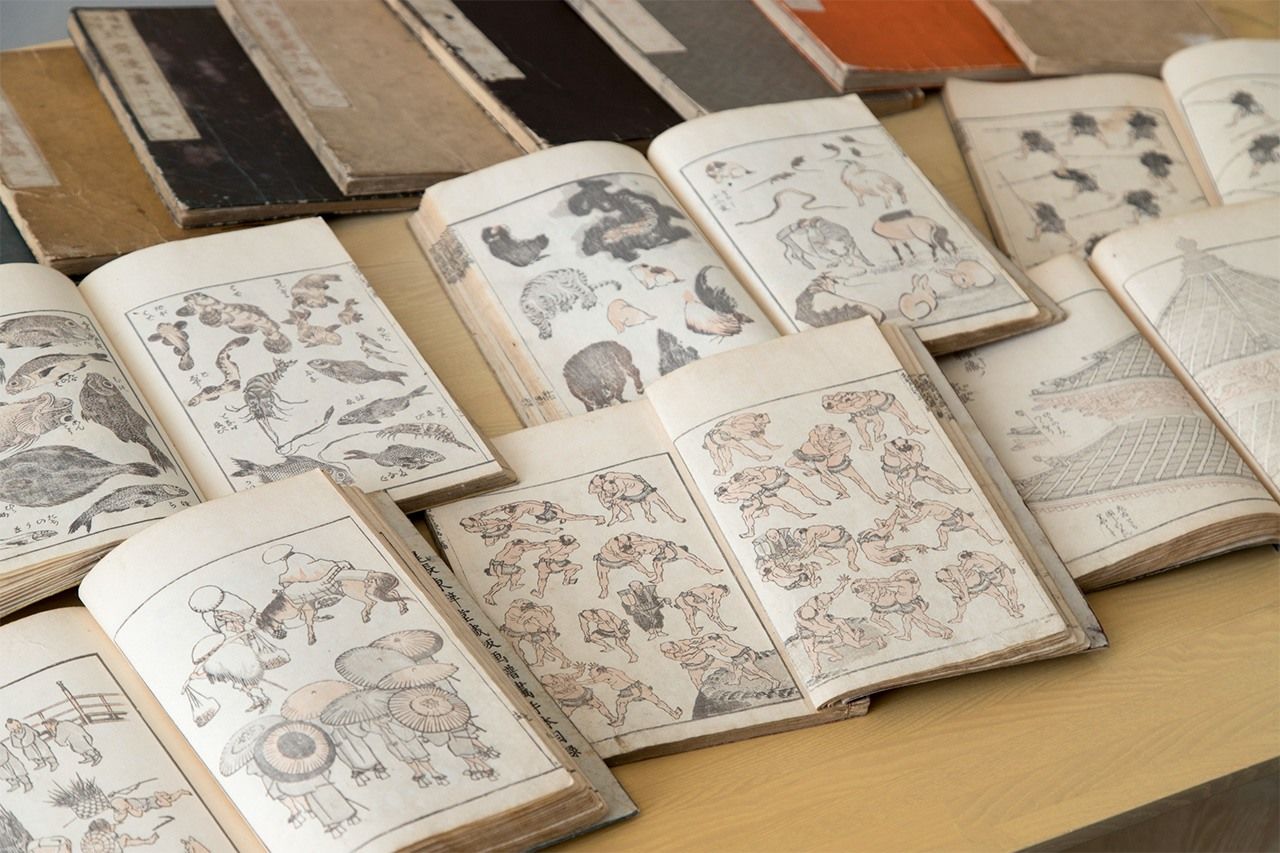
The woodblock prints of Hokusai, including the sketchbooks known as Hokusai manga, shown here, had a major impact on the Impressionist painters.
Art Is Not an Indulgence
URAGAMI It’s great to incorporate Hokusai’s designs in Japanese passports, but how many Japanese travelers would even be able to tell the foreigners who look at their passports about Hokusai and his artistic achievements? Very few, I’ll warrant. I would like the Japanese to reach the point where they can do that. And I would like Japan to develop its cultural infrastructure to a level where it can say to foreign visitors, “Welcome to the birthplace of ukiyo-e. Now we’d like to show you ukiyo-e at its best.”
INTERVIEWER Westerners began buying up ukiyo-e in the second half of the nineteenth century, struck by its artistic quality, and it ended up having a major impact on Impressionism and other schools of Western art. At that time, apparently, the Japanese couldn’t understand what all the fuss was about.
URAGAMI It’s not that the Japanese were incapable of appreciating ukiyo-e. After all, it was extremely popular among the merchant class in the Edo period. But it was so common and familiar that no one attached that much value to it. Their attitude toward Western dealers and collectors was, “If you like it that much, you’re welcome to it.”
Japan is a highly artistic nation. It’s produced a huge amount of great art over the centuries. But contemporary Japanese society doesn’t have the proper respect for art. This is apparent in the reluctance to buy art, which I mentioned before. People who have a little extra money all want to spend it on houses or cars, overseas travel or fine dining. There’s nothing wrong with those things, but in a culturally advanced country, you would expect a certain percentage of those people to turn their attention to art. Yet hardly anyone in Japan buys art nowadays, and those who do don’t get much respect. Art here is seen as an indulgence, an extravagant hobby, whereas in other countries, it’s viewed as a valuable asset and even a sound investment.
Until the Japanese get over this notion of art as a superfluous indulgence, Japan is never going to emerge as a major cultural power. And where does that leave us? We’re not going to become a major political or military player. And we’re unlikely to regain our status as an economic superpower. If we want to maintain our relevance in the international community, we need to work on enhancing our stature as a center of culture.
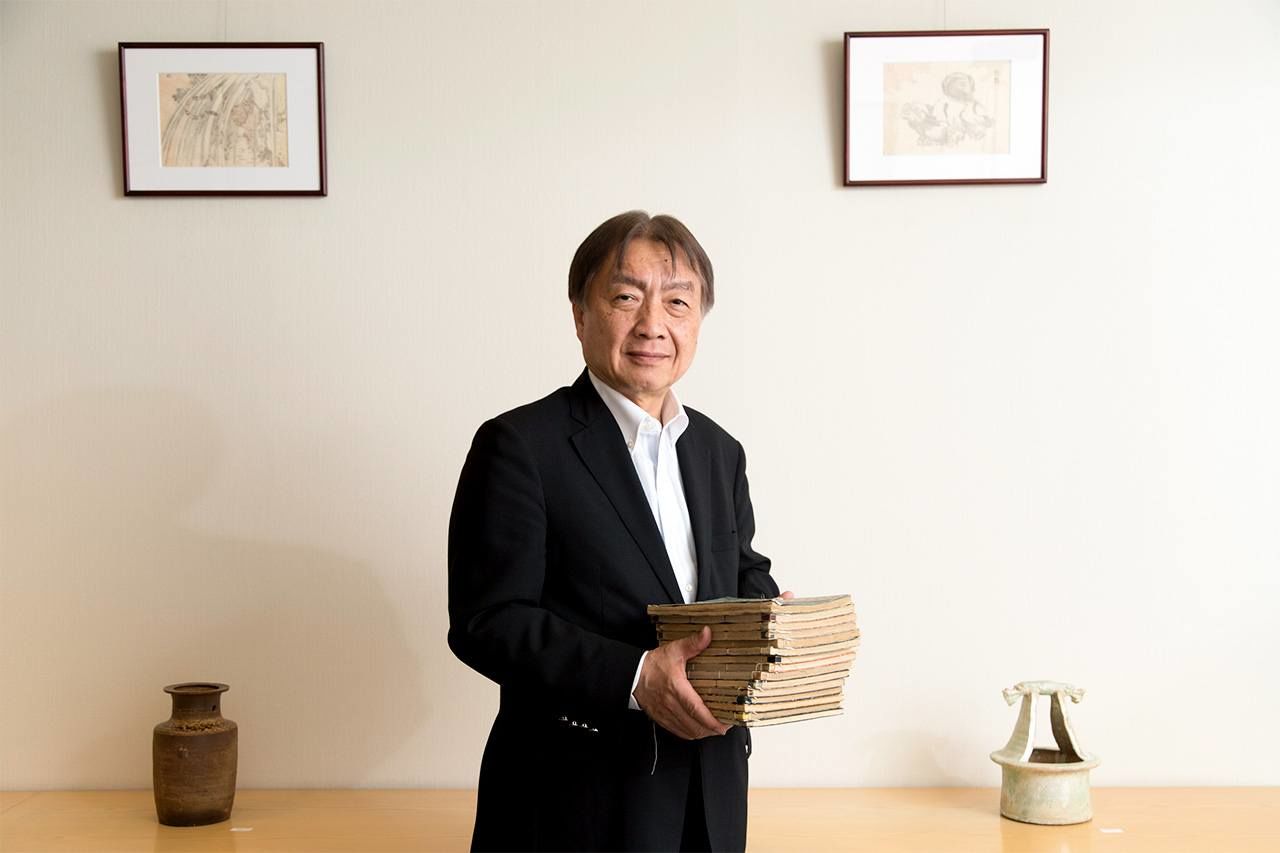
Uragami with a sampling from his Hokusai manga collection.
(Originally written in Japanese by Ishii Masato of Nippon.com and published on May 30, 2019. All photographs by Kawamoto Seiya. Banner photo: Uragami Mitsuru at his Asian art gallery, Uragami Sōkyū-dō, in Nihonbashi, Tokyo, on May 24, 2019.)